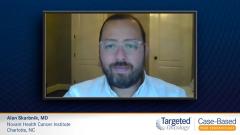
Treating Early Relapse in Follicular Lymphoma
Alan Skarbnik, MD, explains early relapse in follicular lymphoma and the available treatment options.
Alan Skarbnik, MD: Nineteen months after diagnosis, the patient presented the same symptoms he had at baseline: chills, fever, worsening fatigue, highly concerning for relapse of disease.
Of all the patients with follicular lymphoma who present and are treated with a frontline chemoimmunotherapy, about 20% have early relapse, a little bit more in patients who receive CHOP [cyclophosphamide, doxorubicin, vincristine, prednisone] or CVP [cyclophosphamide, vincristine, prednisone] as the chemotherapy, a little bit less in patients who receive bendamustine as initial chemotherapy.
However, we see a higher rate of high-grade transformation in patients who receive bendamustine and present with early relapse, showing that bendamustine doesn’t necessarily prevent high-grade transformation but it does decrease the rate of early progression overall compared with what we see with CHOP or CVP.
This is of concern because there are studies showing that progression of disease within the first 24 months [POD24] post treatment is a high predictor of poor overall survival. There are a couple of different studies. The CONSORT study is the most cited one…. They have retrospective studies from the British Columbia Cancer Consortium evaluating patients. In their cohort it reflects the same findings. The likelihood of death in patients who present with POD24 is much higher than for those patients who present with longer-term relapse.
For instance, in the CONSORT study, for patients who presented with progression of disease less than 2 years after initial treatment, the 5-year overall survival was 50% versus 90% for those patients who presented with progression of disease beyond 2 years or did not have progression of disease at all.
This trend was capped after it was adjusted for FLIPI [Follicular Lymphoma International Prognostic Index] at baseline…. There was a 6 times higher chance of death for patients who had early progression compared with patients who did not have early progression. That’s very important when evaluating and treating patients with follicular lymphoma and certainly a concern we have with patients who have early relapse, or early progression.
That does not change whether patients are receiving maintenance therapy or not. Patients who do have progression with maintenance therapies still have a higher risk of death, a lower overall survival. The same results were found for patients who do not receive maintenance therapy. They also have a lower chance of overall survival if disease recurs, or progresses, or relapses within 24 months of diagnosis.
The outcomes for these patients are certainly inferior to patients who don’t present with early progression. In that setting, that’s when I personally consider more intensive therapies to try to overcome the poorer prognosis that these patients have at that time.
In patients who are fit, I would consider salvage chemotherapy, followed by autologous stem cell transplantation. Now for patients who have disease relapse after the second line, or third line, or further, CAR [chimeric antigen receptor] T-cell therapy may be an option for these patients, again trying to overcome the poor prognosis that these early recurrences portend.
In patients who are not fit, we have other treatment options, including induction with a different chemotherapy and/or an anti-CD20 [antibody] backbone, not with intent to transplant, using a lenalidomide-based salvage regimen.
Now we have an EZH2 inhibitor. EZH2, whether it’s wild type or mutated, has an important role in the development of follicular lymphoma. Tazemetostat may be used for these patients. We do have PI3 kinase inhibitors that may be used for these patients in relapsed disease. The newer PI3K inhibitors tend to be better tolerated than the first generation.
We do have a couple of different options for these patients. But again, in patients who present with progression of disease early on, my personal take, if feasible, is to provide them with more intensive treatment followed by consolidation with autologous stem cell transplantation, or CAR T if there are further lines of therapy.
For this patient who presented with early progression 19 months after treatment with obinutuzumab and CHOP, the expected outcome is certainly poorer than for a patient who would have longer control of the disease.
The age-adjusted hazard ratio for overall survival for patients with disease progression within 24 months versus those without disease progression is 12.2 based on studies previously published.
Again, because of a much poorer prognosis, this patient in particular would be someone who I believe would benefit from an intense salvage regimen followed by autologous stem cell transplantation. This patient, who is 60 and without any significant comorbidities, would be an appropriate candidate for the stem cell transplant approach.
Transcript edited for clarity.
A 60-Year-Old Man with Follicular Lymphoma
Initial presentation
A 60-year-old man presents with a 4-month history of fatigue, decreased appetite, occasional fevers, and a 7-lb unintentional weight loss
PMH: Unremarkable
PE: palpable right axillary lymph nodes, ~2.5 cm and bilateral cervical lymph nodes, ~3 cm, spleen palpable 4 cm below left costal margin
Clinical workup
Labs: ANC 1.6 x 10^9, WBC 11.4 x 10^9, lymphocytes 42%, HB 9.7 g/dL, plt 97 x10^9, LDH 402U/L, 3.4 B2M ug/mL; HBV negative
Excisional biopsy of axillary lymph node on IHC showed CD20+, CD3+, CD5+, BCL2+, Follicular lymphoma grade 2
Bone marrow biopsy showed paratrabecular lymphoid aggregates, 38% involvement
Cytogenetics: t(14:18) (Q32;q21)
Molecular testing: EZH2 wild type
PET/CT showed right axillary, bilateral cervical, and mediastinal lymphadenopathy (3.1 cm, 3.1 cm, and 2.6 cm respectively)
Ann Arbor Stage IV, ECOG PS is 1
Treatment
Patient was treated with obinutuzumab plus cyclophosphamide, doxorubicin, vincristine, and prednisone (CHOP) chemotherapy. He completed 6 cycles and treatment was well tolerated.
He continued on obinutuzumab maintenance.
19 months later, he complains of fevers, chills, and worsening fatigue.








































